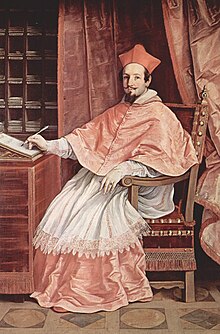Bernardino Spada
|
His Eminence Bernardino Spada |
|
|---|---|

Cardinal Spada. Oil painting by Guido Reni, c. 1631. Galleria Spada, Rome
|
|
| Other posts | Cardinal-bishop of Palestrina |
| Orders | |
| Ordination | 1623 |
| Consecration | 8 December 1623 by Guido Bentivoglio d'Aragona |
| Created Cardinal | 19 January 1626 by Pope Urban VIII |
| Rank | Cardinal-priest, later cardinal-bishop |
| Personal details | |
| Born |
21 April 1594 Brisighella, Italy |
| Died | 10 November 1661 (aged 67) Rome, Italy |
| Buried | San Girolamo della Carità, Rome |
| Nationality | Italian |
| Denomination | Roman Catholic |
| Parents | Paolo Spada |
| Previous post |
Apostolic nuncio to France (1623-1627) Titular archbishop of Tamiathis (1623-1626) Cardinal-priest of Santo Stefano al Monte Celio (1627-1642) Camerlengo of the Sacred College of Cardinals (1638-1639) Cardinal-priest of San Pietro in Vincoli (1642-1646) Cardinal-bishop of Albano (1646-1652) Cardinal-bishop of Frascati (1652) Cardinal-bishop of Sabina (1652-1655) |
| Alma mater |
University of Bologna University of Perugia |
Bernardino Spada (21 April 1594 – 10 November 1661) was an Italian Cardinal of the Roman Catholic Church and a patron of the arts whose collection is housed in the Palazzo Spada in Rome.
Spada was born in Brisighella, current province of Ravenna (Romagna). His father was the rich merchant Paolo Spada (unrelated to the Spada family of ancient nobility) who had directed him early on to a career in the church, though the generations before his had been colliers. Bernardino studied law in Bologna, Perugia and Rome and received a doctorate. He served in the Papal Curia from 1617.
On December 8, 1623, he was consecrated bishop in the church of S. Luigi de' Francesi in Rome by Cardinal Guido Bentivoglio d'Aragona, assisted by Guillaume du Nozet, Titular Archbishop of Seleucia, and by François Boyvin de Péricard, Bishop of Evreux. In December 1623 he was appointed papal nuncio to the court of France, in preparation for which he was ordained titular archbishop of Tamiathis. He served as nuncio until 1627, when he became papal legate in Bologna. He was made a cardinal 19 January 1626 by Pope Urban VIII. When the plague epidemic hit Bologna in 1630/1631, he helped organize the health care system there.
...
Wikipedia
